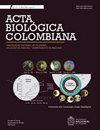FEEDING HABITS OF Paralonchurus brasiliensis (PERCIFORMES: SCIAENIDAE) FROM SOUTH OF BRAZIL
IF 0.4
4区 生物学
Q4 PLANT SCIENCES
引用次数: 3
Abstract
Shrimp trawling directly impacts target species and non-target species, altering micro-habitats and marine trophic webs. Thus, the objective of the present research was to analyze the feeding habits of Paralonchurus brasiliensis as a tool to evaluate the impact of trawling on the food chains in marine environments, in the South Atlantic of Brazil. One thousand and nineteen stomachs of P. brasiliensis were dissected after being captured as bycatch of shrimp Xiphopenaeus kroyeri, in Penha, on the north central coast of Santa Catarina, Brazil. The number of stomachs was enough to describe the feeding habits of P. brasiliensis, characterizing it as a carnivorous species and predominantly invertivorous. They also revealed that this species has a diversified and constant diet, with greater consumption of polychaetes, crustaceans, and ofiuroides, among other components of the macrobentos, all closely related to the sediment. It was also found that the target species X. kroyeri is not an important prey in the diet of P. brasiliensis, despite occupying the same habitat. According to the present study, P. brasiliensis can be characterized as a demersal-benthic species, predator, opportunistic and broad trophic spectrum. This work contributes to the understanding of trophic chains of the coastal ecosystems, using the P. brasiliensis as a model.巴西南部巴西绵蚊的摄食习性(蚊目:绵蚊科)
对虾拖网捕捞直接影响目标物种和非目标物种,改变微栖息地和海洋营养网。因此,本研究的目的是分析巴西南大西洋海洋环境中拖网捕捞对食物链的影响,以此作为评估拖网捕捞对巴西南大西洋海洋环境食物链影响的工具。在巴西圣卡塔琳娜州中北部海岸的Penha,作为副渔获物捕获的克罗耶对虾(Xiphopenaeus kroyeri),对巴西p.b asiliensis的一千九十九个胃进行了解剖。胃的数量足以描述巴西螺的摄食习性,表明其为肉食性物种,以无食性为主。他们还揭示了这个物种有一个多样化和恒定的饮食,在大型便当动物的其他成分中,有更多的消费多毛类,甲壳类和类动物,所有这些都与沉积物密切相关。结果表明,靶种克氏棘球绦虫虽与巴西棘球绦虫处于相同的生境,但并非巴西棘球绦虫的重要猎物。根据目前的研究,巴西螺可以被定义为底栖、捕食、机会性和广泛的营养谱。这项工作有助于理解沿海生态系统的营养链,以巴西疟原虫为模型。
本文章由计算机程序翻译,如有差异,请以英文原文为准。
求助全文
约1分钟内获得全文
求助全文
来源期刊

Acta Biologica Colombiana
Agricultural and Biological Sciences-General Agricultural and Biological Sciences
CiteScore
1.60
自引率
0.00%
发文量
21
审稿时长
13 weeks
期刊介绍:
The journal is published quarterly and divulges original and unpublished results of basic and applied research about biological subjects with special interest in Neotropical region. Manuscripts may be research articles, reviews, reflection articles or short notes. The Acta biol. Colomb Journal have a scientific and editorial board composed of expert researchers of in their areas of knowledge.
 求助内容:
求助内容: 应助结果提醒方式:
应助结果提醒方式:


